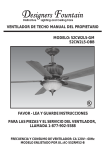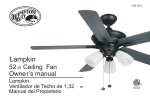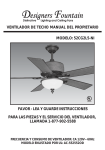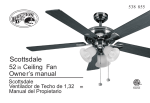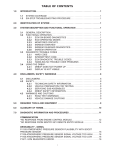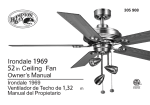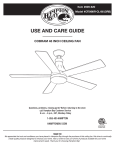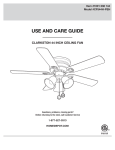Download Progress Lighting P2514-09 Installation Guide
Transcript
Ceiling Fan Installation Manual P2514 PROGRESS LIGHTING 30-YEAR LIMITED WARRANTY PROGRESS LIGHTING FAN MOTORS ARE WARRANTED TO THE END USER TO BE FREE OF ELECTRICAL AND/OR MECHANICAL DEFECTS FOR A PERIOD OF 30 (THIRTY) YEARS FROM DATE OF SALE. PULL CHAIN SWITCHES, REVERSE SWITCHES, CAPACITORS AND METAL FINISHES ARE WARRANTED FOR A PERIOD OF 1 YEAR. WARPING OF WOODEN OR PLASTIC BLADES IS NOT COVERED BY THIS WARRANTY. THE END USER HAS THE OPTION OF RETURNING THE DEFECTIVE FAN TO THE PLACE OF PURCHASE DURING THE FIRST 30 DAYS FOR A REPLACEMENT. AFTER 30 DAYS, THE PURCHASER MUST CONTACT PROGRESS LIGHTING FOR REPAIR OR REPLACEMENT. THE END USER ALSO BEARS THE RESPONSIBILITY FOR ALL COSTS IN THE REMOVAL, SHIPPING AND REINSTALLATION OF FANS OR PARTS FOR REPAIR OR REPLACEMENT. PROGRESS LIGHTING WILL NOT ASSUME LIABILITY OR RESPONSIBILITY FOR DAMAGES (INCLUDING INCIDENTAL OR CONSEQUENTIAL) CAUSED BY THE IMPROPER INSTALLATION OR OPERATION OF THE UNIT OR ITS COMPONENT PARTS, OR BY THE FAILURE OF SUPPORTING HARDWARE NOT SUPPLIED BY PROGRESS LIGHTING. THIS WARRANTY IS GIVEN IN LIEU OF ALL OTHER GUARANTEES, WHETHER EXPRESSED OR IMPLIED, AND IS VOIDED IN CASES OF ABUSE, MISUSE OR IMPROPER HANDLING, NEGLIGENCE, SHIPPING DAMAGE, UNAUTHORIZED REPAIRS (MADE OR ATTEMPTED) OR UNUSUAL APPLICATION. Date Purchased Store Purchased Model No. Serial No. Vendor No. UPC 11221 785247139187 SOME STATES DO NOT ALLOW LIMITATIONS ON HOW LONG AN IMPLIED WARRANTY LASTS OR THE EXCLUSION OR LIMITATIONS OF INCIDENTAL OR CONSEQUENTIAL DAMAGES, SO THE ABOVE LIMITATIONS AND EXCLUSIONS MAY NOT APPLY TO YOU. THIS WARRANTY GIVES YOU SPECIFIC RIGHTS AND YOU MAY HAVE OTHER RIGHTS WHICH VARY FROM STATE TO STATE. 30-YEAR LIMITED WARRANTY Safety Rules..................................................................................................................................... 1. Unpacking Your Fan ......................................................................................................................... 2. Installing Your Fan ........................................................................................................................... 3. Installing the Light Kit...................................................................................................................... 8. Operating Your Transmitter ............................................................................................................. 10. Care of Your Fan ............................................................................................................................. 11. Troubleshooting ............................................................................................................................. 12. Specifications ................................................................................................................................ 13. Table of Contents To avoid personal injury or damage to the fan and other items, be cautious when working around or cleaning the fan. 1. To reduce the risk of electric shock, insure electricity has been turned off at the circuit breaker or fuse box before beginning. 9. 2. All wiring must be in accordance with the National Electrical Code and local electrical codes. Electrical installation should be performed by a qualified licensed electrician. 10. Do not use water or detergents when cleaning the fan or fan blades. A dry dust cloth or lightly dampened cloth will be suitable for most cleaning. 3. WARNING: To reduce the risk of electrical shock and fire, do not use this fan with any solid-state fan speed control device. 11. After making electrical connections, spliced conductors should be turned upward and pushed carefully up into the outlet box. The wires should be spread apart with the grounded conductor and the equipment-grounding conductor on one side of the outlet box. 4. WARNING: To reduce the risk of personal injury, use only the two steel screws (and lock washers) provided with the outlet box for mounting to the outlet box. Most outlet boxes commonly used for the support of lighting fixtures are not acceptable for fan support and may need to be replaced, consult a qualified electrician if in doubt. 12. Electrical diagrams are for reference only. Light kits that are not packed with the fan must be UL Listed and marked suitable for use with the model fan you are installing. Switches must be UL General Use Switches. Refer to the Instructions packaged with the light kits and switches for proper assembly. WARNING TO REDUCE THE RISK OF FIRE, ELECTRIC SHOCK OR PERSONAL INJURY, MOUNT FAN TO OUTLET BOX MARKED ACCEPTABLE FOR FAN SUPPORT. 5. The outlet box and support structure must be securely mounted and capable of reliably supporting a minimum of 50 pounds. Use onlyUL Listed outlet boxes marked FOR FAN SUPPORT. WARNING TO REDUCE THE RISK OF PERSONAL INJURY, DO NOT BEND THE BLADE ARMS (ALSO REFERRED TO AS BRACKETS) DURING ASSEMBLY OR AFTER INSTALLATION. DO NOT INSERT OBJECTS IN THE PATH OF THE BLADES. NOTE READ AND SAVE ALL INSTRUCTIONS! 6. The fan must be mounted with a minimum of 7 feet clearance from the trailing edge of the blades to the floor. 7. To operate the reverse function on this fan, press the reversing button while the fan is running. 8. Avoid placing objects in the path of the blades. 1. Safety Rules ATTENTION Under the Energy Policy Act of 2005, federal regulations require all ceiling fans with light kits manufactured or imported after January 1, 2009, to limit the total wattage consumed by the light kit to 190 watts. Therefore, this product is equipped with a 190W limiting device. If lamping exceeds 190 watts, the light kit will shut off automatically until the proper wattage of bulbs are installed. Reset the light kit by turning it off, replacing the bulbs with the correct wattage, and then turning the light kit back on. 5 2 8 11 1 a 9 3 b 6 12 7 4 . 10 13 Unpack your fan and check the contents. You should have the following items; 1. 2. 3. 4. 5. 6. Fan blades (3) Canopy assembly Ball/downrod assembly Coupling cover Fan motor assembly Mounting plate 7. 8. 9. 10. 11. 12. Light plate Glass shade 10 0 Watt halogen bulb 13. Loose parts bag containing: Receiver with 6 wire nuts a. Blade attachment hardware (10 screws, 10 fiber washers ) Transmitter incl. 2 mounting screws Balancing kit b. Mounting hardware: Wire nuts (3) Unpacking Your Fan Tools Required Figures 1,2 and 3 are examples of different ways to mount the outlet box. Phillips screw driver, straight slot screw driver, adjustable wrench, step ladder, and wire cutters. Provide strong support Recessed outlet box Mounting Options If there isn't an existing UL listed mounting box, then read the following instructions. Disconnect the power by removing fuses or turning off circuit breakers. Secure the outlet box directly to the building structure. Use appropriate fasteners and building materials. The outlet box and its support must be able to fully support the moving weight of the fan (at least 50 lbs). Do not use plastic outlet boxes. Angled ceiling maximum 24 angle Ceiling Mounting Plate Outlet box Figure 3 Note: You may need a longer downrod to maintain proper blade clearance when installing on a steep, sloped ceiling. Figure 1 WARNING TO REDUCE THE RISK OF FIRE, ELECTRIC SHOCK, OR OTHER PERSONAL INJURY, MOUNT FAN ONLY TO AN OUTLET BOX MARKED ACCEPTABLE FOR FAN SUPPORT AND USE THE MOUNTING SCREWS PROVIDED WITH THE OUTLET BOX. OUTLET BOXES COMMONLY USED FOR THE SUPPORT OF LIGHTING FIXTURES MAY NOT BE ACCEPTABLE FOR FAN SUPPORT AND MAY NEED TO BE REPLACED. CONSULT A QUALIFIED ELECTRICIAN IF IN DOUBT. Figure 4 Outlet box Figure 2 3. Installing Your Fan Outlet box To hang your fan where there is an existing fixture but no ceiling joist, you may need an installation hanger bar as shown in Figure 4 (available at your Progress Lighting Hanging the Fan REMEMBER to turn off the power. Follow the steps below to hang your fan properly: Step 1. Remove the decorative canopy bottom cover from the canopy by turning the cover counter clockwise.(Fig. 5) Step 2. Remove the mounting bracket from the canopy by removing the 1 of 2 screws from the bottom of the mounting bracket and loosening the other one a half turn from the screw head. Next, turn the canopy counter clockwise to removing the mounting bracket from the canopy. (Fig, 5) Step 3. Pass the 120-volt supply wires through the center hole in the ceiling hanger bracket as shown in Fig. 6. Step 7. Align the holes at the bottom of the downrod with the holes in the collar on top of the motor housing (Fig.7). Carefully insert the hanger pin through the holes in the collar and downrod. Be careful not to jam the pin against the wiring inside the downrod. Insert the locking pin through the hole near the end of the hanger pin until it snaps into its locked position, as noted in the circle inset of Fig. 7. WARNING FAILURE TO PROPERLY INSTALL LOCKING PIN AS NOTED IN STEP 7 COULD RESULT IN FAN LOOSENING AND POSSIBLY FALLING. Step 8. Tighten two set screws on top of the fan motor firmly (Figure 7) Step 9. Place the downrod ball into the hanger bracket socket. Washers Ceiling mounting plate Hook Figure 6 120V Wires Motor wires Ball/downrod assembly Mounting screws (supplied with electrical box) Pin in locked position Ceiling canopy Canopy cover Ceiling hanger bracket Step 4. Secure the hanger bracket to the ceiling outlet box with the screws and washers provided with your outlet box. Ceiling canopy Step 5. Remove the hanger pin, lock pin and set screws from the top of the motor assembly. Figure 5 Step 6. Route wires exiting from the top of the fan motor through the collar cover, canopy cover, canopy and then through the ball / downrod. (Fig. 7) CUL Listed electrical box Canopy cover Locking pin Tighten screws firmly Collar cover Hanger pin Motor collar Figure 7 4. Make the Electric Connections WARNING: To avoid possible electrical shock, be sure electricity is turned off at the main fuse box before wiring. NOTE: This remote control unit is equipped with 16 code combinations to prevent possible interference from or to other remote units. The frequency switches on your receiver and transmitter have been preset at the factory. Please recheck to make sure the switches on the transmitter and the receiver are set to the same position, any combination of settings will operate the fan as long as the transmitter and receiver are set to the same position.(Figure 8) Step 3. (Figure 10) Receiver to House Supply Wires Electrical Connections: Connect the black (hot) wire from the ceiling to the black wire marked "AC in L" from the receiver. Connect the white(neutral) wire from the ceiling to the white wire marked "AC in N" f r o m t h e R e c e i v e r. S e c u r e t h e w i r e connections with the plastic wire nuts provided. Step 4. (Figure 10) If your outlet box has a ground wire (green or bare copper) connect it to the fan ground wires; otherwise connect the hanging bracket ground wire to the mounting bracket. Secure the wire connection with a plastic nut provided. After connecting the wires spread them apart so that the green and white wires are on one side of the outlet Step 1. (Figure 9) Insert the receiver into the mounting bracket with the flat side of the box and black and blue wires are on he other side. Carefully tuck the wire connections up receiver facing the ceiling. into the outlet box. Step 2. (Fig. 10) Motor to Receiver Electrical Connections: Connect the Black wire from Note: Fan must be installed at a maximum the fan to Black wire marked "TO MOTOR distance of 20 feet from the transmitting unit L". Connect the White wire from the fan for proper signal transmission between the to the White wire marked "TO MOTOR N" transmitting unit and the fan's receiving unit. from the receiver. Connect the Blue wire from the fan to the Blue wire marked "For Light" from the receiver. Secure wire connections with the plastic wire nuts provided. 5. Code switch ON Figure 8 Receiver Hanger bracket Figure 9 BLACK WHITE BLACK SUPPLY CIRCUIT Ground Conductor Step 1. Tuck connections neatly into ceiling outlet box. Outlet Box Step 2. Slide the canopy up to mounting bracket and place the key hole on the canopy over the screw on the mounting bracket, turn canopy until it locks in place at the narrow section of the key holes. (Fig. 11) BLUE BLACK WHITE BLUE BLACK WHITE GREEN ON WHITE Finishing the Installation Green Ground Lead Ground to Downrod Step 3. Align the circular hole on canopy with the remaining hole on the mounting bracket, secure by tightening the two set screws. Note: Adjust the canopy screws as necessary until the canopy and canopy cover are snug. Outlet box Hanger bracket Screws Canopy Canopy cover Figure 11 WARNING Make sure the notch on the hanging bracket properly sits in the groove in the hanger ball before attaching the canopy to the bracket by turning the housing until it drops into place. BLUE WHITE BLACK WHITE Figure 10 6. Attaching the Fan Blades Insert the blade through the slot in housing. Align holes in blade and motor and secure with 3 screws and fiber washers. Repeat process with the other blades. (Fig. 12) Blade Balancing All blades are grouped by weight. Because natural woods very in density, the fan may wobble even though the blades are weighed equally. WARNING TO REDUCE THE RISK OF PERSONAL INJURY, DO NOT BEND THE BLADE HOLDERS WHILE INSTALLING, BALANCING THE BLADES, OR CLEANING THE FAN. DO NOT INSERT FOREIGN OBJECTS BETWEEN ROTATING FAN BLADES. The following procedure should correct most fan wobbling problems. Check after each step. Touching ceiling 1. Check that all blade and blade arm screws are secure. Slot Blade Fiber washer 2. Most fan wobbling problems are caused when blade levels are unequal. Check this level by selecting a point on the ceiling above the tip of one of the blades. Measure this distance as shown in Figure 13. Rotate the fan until the next blade is positioned for measurement. Repeat for each blade. The distance deviation should be equal within 1/8". 3. Use the enclosed Blade Balancing Kit if the blade wobble is still noticeable. Screws Figure 12 7. 4. If the blade wobble is still noticeable, interchanging two adjacent (side by side) blades can redistribute the weight and possibly result in smoother operation. Figure 13 Installing the Mounting Plate REMEMBER: To disconnect the power. The fan blades must be already attached to the fan. Step 1. Remove 1 of the 3 screws from the mounting ring and loosen the other 2 screws. (Do not remove) Step 1. Remove the 3 screws from the mounting plate and keep it for future use. Step 2. Place the key holes on the mounting plate over the 2 screws previously loosened from the mounting ring, turn mounting plate until it locks in place at the narrow section of the key holes. Secure by tightening the 2 screws previously loosened and the one previously removed. (Fig. 14) Step 2. Raise and hold the light plate close to the mounting ring and proceed to do the wire connections. Connect the white wire connectors from the light plate and fan, follow the same procedure with the black wire connectors. (Fig. 15) Step 3. Tuck connections neatly into mounting plate. Secure by tightening the 3 screws previously removed.(Fig. 15). Step 4. Install 100W halogen bulb (included). (Fig. 16) Instructions pertaining to a risk of fire, or injury to persons important safety instructions lighted lamp is hot! Warning-to reduce risk of fire or injury to persons A.- Turn off/unplug and allow to cool before replacing lamp. B.- Lamp gets hot quickly contact only switch/plug when turning on. C.- Do not touch hot lens, guard, or enclosure. D.- Do not remain in light if skin feels warm. E.- Do not look directly at lighted lamp. F.- Keep lamp away from materials that what burn. G.- Use only with wattage or lamp marked on fixture. H.- Do not touch the lamp at any time. oil from skin may damage lamp. use a soft dry cloth. (halogen lamp may be cleaned with rubbing alcohol.) halogen lamps operate at extremely high temperatures and pressures. they will shatter if not handled correctly. I.- Do not operate the luminaire fitting with a missing or damaged shield. J.- Do not place near water. K.- Not for outdoor use. Step 5. Raise glass shade up against the mounting plate and secure it to fan by twisting glass clockwise until snug. DO NOT OVERTIGHTEN. (Fig. 16) Mounting ring Screws Mounting plate Figure 14 Installing the Light Kit 8. Installing the battery: Install 12V MN21/A23 battery (included), to prevent damage to transmitter, remove the battery if not used for long periods. Bulb Connection plugs Mounting plate Light plate Screws Glass shade Figure 15 9. Figure 16 Figure 17 " button (inside the battery Restore power to ceiling fan and test for 4. The " compartment in the back side of the proper operation. 1. " , , " buttons: These three buttons are used to set the fan speed as follows: = Low speed = Medium speed = High speed 2. " " button: This button turns the fan off. 3. The " " button turns the light ON or OFF and also controls the brightness setting. Press and release the button to turn the light ON or OFF. Press and hold the button to set the desired brightness. The light key has an auto-resume, it will stay at the same brightness as the last time it was turned off. transmitter)-Fan reversing function, used to set the fan forward or reverse, press the button forward (for warm weather) or reverse (for cool weather): Speed settings for warm or cool weather depend on factors such as the room size, ceiling height, number of fans, etc. NOTE: To operate the reverse function on this fan, press the reverse button while the fan is running. Figure 19 Warm weather - (Forward) A downward air flow creates a cooling effect as shown in Figure 19. This allows you to set your air conditioner on a higher setting without affecting your comfort. Cool weather - (Reverse) An upward airflow moves warm air off the ceiling area as shown in Figure 20. This allows you to set your heating unit on a lower setting without affecting your comfort. Figure 20 Figure 18 Operating Your Transmitter 10. Here are some suggestions to help you maintain your fan 1.Because of the fan's natural movement, some connections may become loose. Check the support connections, brackets, and blade attachments twice a year. Make sure they are secure. (It is not necessary to remove fan from ceiling.) 2. Clean your fan periodically to help maintain its new appearance over the years. Use only a soft brush or lint-free cloth to avoid scratching the finish. The plating is sealed with a lacquer to minimize discoloration or tarnishing. Do not use water when cleaning. This could damage the motor, or the wood, or possibly cause an electrical shock. 3. You can apply a light coat of furniture polish to the wood blades for additional protection and enhanced beauty. Cover small scratches with a light application of shoe polish. 4. There is no need to oil your fan. The motor has permanently lubricated bearings. IMPORTANT MAKE SURE THE POWER IS OFF AT THE ELECTRICAL PANEL BOX BEFORE YOU ATTEMPT ANY REPAIRS. REFER TO THE SECTION "MAKING ELECTRICAL CONNECTIONS" 11. Care of Your Fan Problem Solution Fan will not start. 1.Check circuit fuses or breakers. 2. Check line wire connections to the fan and switch wire connections in the switch housing. CAUTION: Make sure main power is off. 3. Check to make sure the dip switches from the transmitter and receiver are set to the same frequency. Fan sounds noisy. 1. Make sure all motor housing screws are snug. 2. Make sure the screws that attach the fan blade bracket to the motor hub is tight. 3. Make sure wire nut connections are not rubbing against each other or the interior wall of the switch housing. CAUTION: Make sure main power is off. 4. Allow a 24-hour "breaking-in" period. Most noise associated with a new fan disappear during this time. 5. If using an optional light kit, make sure the screws securing the glassware are tight. Check that light bulb is also secure. 6.Some fan motors are sensitive to signals from solid-state variable speed controls. If you have installed this type of control, choose and install another type of control. 7. Make sure the upper canopy is a short distance from the ceiling. It should not touch the ceiling. Lights shut off and will not come back on. 1. This unit is equipped with a wattage limiting device. Lamping in excess of 190 watts will disable your ceiling fan's light kit. To reset your light kit you must turn the power off and re lamp, keeping the wattage under 190 watts. Restore power to your ceiling fan and continue normal operation. Troubleshooting 12. Fan Size 52" Speed Volts Amps Watts RPM CFM Low 120 0.35 14 74 1911 Medium 120 0.47 35 123 2679 High 120 0.52 51 160 3613 These are approximate measures. They do not include Amps and Wattage used by the light kit. C 2005 Progress Lighting Co. 101 Corporate Dr., Spartanburg, SC 29304-5704 All Rights Reserved 13. Specifications N.W. G.W. C.F. 16.17 lbs 19.8 lbs 1.6' GARANTÍA LIMITADA DE 30 AÑOS LOS VENTILADORES PROGRESS LIGHTING GARANTIZAN AL CONSUMIDOR ESTAR LIBRES DE DEFECTOS ELÉCTRICOS Y/O MECÁNICOS POR UN PERÍODO DE 30 AÑOS A PARTIR DE LA FECHA DE VENTA. LOS INTERRUPTORES CON CADENA, LOS INTERRUPTORES DE INVERSIÓN, LOS CONDENSADORES Y LAS TERMINACIONES METÁLICAS ESTÁN GARANTIZADAS POR UN PERÍODO DE 1 AÑO. LAS PALETAS PANDEADAS DE MADERA O PLÁSTICO NO ESTÁN CUBIERTAS POR ESTA GARANTÍA. EL CONSUMIDOR TIENE LA OPCIÓN DE DEVOLVER EL VENTILADOR DEFECTUOSO PARA SU CAMBIO AL NEGOCIO DE ADQUISICIÓN DURANTE LOS 30 DÍAS SIGUIENTES. DESPUÉS DE 30 DÍAS, EL COMPRADOR DEBE CONTACTAR PROGRESS LIGHTING PARA LA REPARACIÓN O REEMPLAZO. EL CONSUMIDOR SE HARÁ CARGO DE TODOS LOS COSTOS DE TRANSPORTE, EXPEDICIÓN Y REINSTALACIÓN DE LOS VENTILADORES O DE LAS PARTES PARA REPARAR O REEEMPLAZAR. PROGRESS LIGHTING NO ASUMIRÁ OBLIGACIONES O RESPONSABILIDAD POR DAÑOS (INCLUYENDO INCIDENTALES O CONSIGUIENTES) CAUSADOS POR EL USO O LA INSTALACIÓN IMPROPIA DE LA UNIDAD O DE SUS PARTES COMPONENTES, O POR LA FALLA DEL EQUIPO DE SOPORTE NO SUMINISTRADO POR PROGRESS LIGHTING . ESTA GARANTÍA ESTÁ DADA EN LUGAR DE TODAS LAS OTRAS GARANTÍAS, SEAN ÉSTAS EXPRESAS O IMPLÍCITAS, Y ES INVÁLIDA EN CASOS DE ABUSO, USO O MANEJO INCORRECTOS, TRATAMIENTO NEGLIGENTE, DAÑOS OCASIONADOS POR EL TRANSPORTE, REPARACIONES NO AUTORIZADAS (REALIZADAS O TENTATIVAS) O APLICACIÓN INUSUAL. Fecha de compra Lugar de compra N de modelo. N de serie Numero de vendedor UPC 11221 785247139224 ALGUNOS ESTADOS NO RECONOCEN LIMITACIONES EN EL TÉRMINO DE LA GARANTÍA IMPLICADA O LA EXCLUSIÓN O LIMITACIÓN DE LOS DAÑOS INCIDENTALES O CONSIGUIENTES, ENTONCES LAS LIMITACIONES Y EXCLUSIONES PRECEDENTES PUEDEN NO SER APLICABLES A UD. ESTA GARANTÍA LE OTORGA DERECHOS ESPECÍFICOS Y UD. PUEDE TENER OTROS DERECHOS QUE VARÍEN DE ESTADO EN ESTADO. GARANTÍA LIMITADA DE 30 AÑOS Normas de seguridad ...................................................................................................................................................................... 1. Cómo desembalar el ventilador ...................................................................................................................................................... 2. Cómo instalar el ventilador ............................................................................................................................................................ 3. Instalación del kit de luz ................................................................................................................................................................ 8. Operando su transmisor ..............................................................................................................................................................10. Cómo cuidar del ventilador .......................................................................................................................................................... 11. Resolución de problemas ............................................................................................................................................................. 12. Especificaciones ........................................................................................................................................................................... 13. Tabla de Contenido 1. Para reducir el riesgo de eléctrocución, asegurarse de que la eléctricidad se ha desactivado en el cortacircuitos o caja de fusibles antes de comenzar. 2. Todo cableado debe relizarse conforme al Código Electrico Nacional y los códigos electricos locales. La instalación eléctrica debe ser relazada por un eléctricista registrado calificado. 3. ADVERTENCIA: Para reducir el riesgo de una electrocuion e incendio, no usar este ventilador con ningun dispositivo de esto s lido para control de la velocidad del ventilador. 4. ADVERTENCIA: Para reducir el riesgo de daños personales, utilice sólo los dos tornillos de acero (y arandelas de bloqueo) suministrados en la caja del enchufe para el montaje en ésta. La mayoría de cajas de enchufes usadas comúnmente para instalaciones de luz no sirven para soportar un ventilador y puede que necesite cambiarlas; si tiene dudas, consulte con un electricista cualificado. ADVERTENCIA PARA REDUCIR EL RIESGO DE INCENDIO ELECTROCUCIÓN O LESIONES PERSONALES. MONTAR EL VENTILADOR EN UNA CAJA DE DISTRIBUCIÓN MARCADA CÓMO ACEPTABLE PARA SOPORTE DE VENTILADORES. 5. La caja de distribución y la estructura de soporte deben estar montados de manera segura y deben ser capaces de soportar, de manera confiable, unminimo de 35 libras (15.9 kilogramos). Usar solamente cajas de distribución listadas por UL. marcadas "PARA SOPORTEDE VENTILADORES". 6. EL ventilador debe estar montado con un m nimo de 7 pies (213cm) de espacio libre desde el borde posterior de las aspas hasta el piso. 7. Invierta el ventilador con el motor encendido a cualquier velocidad. 8. Evitar colocar objetos qen interfiera el giro de las aspas. 9. Para evitar lesiones personales o da os al ventilador y otros articulos, tener cuidado al trabajar cerca del ventilador o al limpiarlo. 1. Normas de seguridad 10. No usar agua o detergentes al limpiar el ventilador o las aspas del ventilador. Para la mayoria de los propsitos de limpieza, un paño seco o ligeramente humedecido será apropiado. 11. Despues de realizar las conexiones eléctricas, los conductores empalmados se deben voltear hacia arriba y se deben empujar con cuidado hacia dentro de la caja de distribución. Los cables deben estar separados, con el conductor a tierra y el conductor a tierra del equipo en un lado de la caja de distribución. 12. Los diagramas eléctricos son para referencia únicamente. Los juegos de iluminación que no estén embalados con el ventilador deben estar Listados por U.L. y marcados como apropiados para ser usados con el modelo de ventilador que se está instalando. Los interruptores deberán ser Interruptores para uso general U.L. Réfierase a las instrucciónes embaladas con los juegos de iluminación e interruptores para obtener información sobre el montaje adecuado. ADVERTENCIA PARA REDUCIR EL RIESGO DE LESIONES PERSONALES, NO DOBLAR LOS SOPORTES DE LAS ASPAS (TAMBIEN LLAMADOS"REBORDES" DURANTE EL MONTAJE O DESPUES DE LA INSTALACIÓN NO INSERTAR OBJETOS EN LA TRAYECTORIA DE LAS ASPAS. NOTA !LEER Y GUARDAR TODAS LAS INSTRUCCIONES! ATENCIÓN En el Acto de política energética de 2005, las regulaciones Federales exigen que todos los ventiladores de techo con juegos de luz fabricados o importados tras el 1 de enero de 2009 limiten el consumo en vatios del juego de luz a 190 vatios. Por lo tanto, este producto está equipado con un dispositivo de limitación a 190W. Si la lámpara consume más de 190 vatios, el juego de luz se apagará automáticamente hasta que se instalen bombillas con el voltaje adecuado. Reinicie el juego de luz apagándolo, cambiando las bombillas por otras del voltaje correcto y volviendo a encenderlo. 5 2 8 11 1 a 9 3 b 6 12 7 4 10 13 Desembalar el ventilador y revisar el contenido. Debe tener los siguientes elementos: 1. 2. 3. 4. 5. 6. Juego de aspas (3) Escudete superior Conjunto de bola/tubo de suspensión Cubridor del motor Conjunto de motor del ventilador. Plato de montaje 7. 8. 9. 10. 11. 12. Plato de luz Pantalla de luz Bombilla de Halogeno de 100W Receptor + 6 tuercas de cable Transmisor + soporte + 2 tornillos de montaje Juego de balanceo 13. Dos bolsas de piezas pequeñas: a. Piezas de fijación de las aspas (10 Tornillos, 10 Arandelas de fibra) b. Piezas demontaje (3 conectores plásticos para cables eléctricos). Cómo desembalar el ventilador 2. Herramienta necesarias Angulo máximo en el techo: 24° Destornillador Phillips, destornillador normal, llave de tuercas ajustable, escalera de tijera, y cortadoras de alambre. Opciones de instalación Caja de distribución embutida Si no hay una caja con UL registración de montaje existente, sirvase leer las siguientes instrucciones. Desconectar el suministro de electricidad removiendo los fusibles o desactivando los cortacircuitos. Asegurar la caja de distribución directamente a la estructura del edificio. Usar los sujetadores y meteriales de construcción apropiados. La caja de distribución y su soporte deben ser capaces de soportar completamente el peso en movimiento del ventilador (al menos 35 libras o 15.9 kgs.) No usar cajas de distribución plásticas. Caja de Distribución Figura 1 Brindar soporte fuerte Soportede Montajeen el Techo Figura 3 Nota: Ud. Puede necesitar una barra de extension para mantener la distancia apropiada de las aspas cuando la instalación se efectúe en un techo inclinado. Las figuras 1,2 y 3 son ejemplos de diferentes maneras de montar la caja de distribución. ADVERTENCIA PARA REDUCIR EL RIESGO DE INCENDIO, ELECTROCUCIÓN O DAÑO PERSONAL, INSTALAR EL VENTILADOR A UNA CAJA DE DISTRIBUCION MARCADA "ACEPTADA PARA SOPORTAR VENTILADOR" Y USAR LOS TORNILLOS DE MONTAJE SUMINISTRADOS CON LA CAJA DE DISTRIBUCION Caja de Distribución Figura 2 3.Cómo instalar el ventilador Figura 4 Caja de distribución Para colgar su ventilador donde ya existe una instalación pero no una viga de techo, es possible que se necesite una instalación de barra de suspención como se muestra la Figura 4 (disponible en su distribuidor Progress Lighting). Colocación del ventilador RECUERDE desconectar la alimentación. Siga estos pasos para colocar correctamente el ventilador: Paso 1. Retire la tapa embellecedora del fondo del cobertor girando la tapa en sentido de las agujas del reloj. (Fig. 5) Paso 2. Quite el soprte de montaje de la cubierta quitando 1 de los 2 tornillos de la parte inferior del soprte de montaje y aflojando el otro media vuelta desde la cabeza del tornillo. A continuación, gire la soprte de montaje en sentido contrahorario para quitar la cubierta. (Fig. 5) Paso 7. Alinee los agujeros de la parte inferior de la barra con los agujeros del cuello en la parte superior de la caja del motor (Fig. 7) Introduzca con cuidado el pasador de suspensión a través de los agujeros del cuello y de la barra. Tenga cuidado de que el pasador no se atasque con los hilos de dentro de la barra. Introduzca el pasador de bloqueo a través del agujero cercano al extremo del pasador de suspensión hasta que quede en la posición de bloqueo, tal y cómo se especifica en el circulo de la Fig. 7. AVISO SI NO INSTALA EL PASADOR CORRECTAMENTE TAL Y CÓMO SE ESPECIFICA EN EL PASO 7, EL VENTILADOR PODRIA AFLOJARSE E INCLUSO CAER. Caja de eléctrica aprobada por CUL Placa de montaje de techo Arandelas Gancho Hilos de 120V Cables del motor Ensamblaje de bola/barra Paso 5. Retire el pasador de suspensión, el pasador de bloqueo y el conjunto de tornillos y de la parte superior del ensamblaje del motor. Paso 6. Guíe los cables que salen de la parte superior del motor del ventilador a través de la voluta decorativa, tapa de la cubierta, cubierta y luego a traves de la bola/varilla. (Fig. 7) Pasador en posición de bloqueo Caja de techo Paso 3. Pase los hilos de 120 voltios a través del agujero central del soporte de suspensión Paso 8. Apriete bien los dos tornillos de la parte del techo tal y cómo se muestra en la. (Fig. 6.) superior del motor (Fig. 7) Paso 4. Fije el soporte de suspensión a la caja Paso 9. Coloque la bola de la barra en la ranura del del techo con los tornillos y arandelas soporte de suspensión. suministradas en la caja. Tornillos de montaje (suplidos en la caja eléctrica) Tapa de la caja Voluta decorativa Pasador de bloqueo Apriete bien los tornillos Pasador del soporte colgante Collar del motor Montaje de techo Figura 7 Escudete de techo Circulo de escudete 4. Realice las Conexiones Electricas AVISO: Para evitar posibles descargas eléctricas, asegurese de que la eléctricidad esta antes de realizar el cableado. NOTA: Está unidad con control a distancia está equipada con 16 combinaciones de códigos diferentes para evitar posibles interferencias de otras unidades a distancia. Los interruptores de frecuencia del receptor y del transmisor están preestablecidos desde fabrica. Por favor, compruebe que los interruptores del transmisor y del receptor estén en la misma posición. El ventilador funcionara con cualquier combinación siempre que el transmisor y el receptor estén en la misma posición. (Fig. 8) Paso 1. (Fig. 9) Instale el receptor en la abrazadera de montar, el lado plano debe quedar hacia arriva. Paso 2. (Fig. 10) Conecciones del motor a el receptor: Conecte el alambre negro del abanico a el alambre negro marcado "To Motor L" del receptor. Conecte el alambre blanco del abanico a el alambre blanco marcado "To Motor N" del receptor. Conecte el alambre azul del abanico a el alambre azul marcado "For Light" del receptor. Asegure las conecciónes con los conectores de alambres proveidos. 5. Paso 3. (Fig. 10) Conecciónes del receptor a los alambres alimentación: Conecte el alambre negro (corriente) de la caja de salida a el alambre negro marcado "AC in L" del receptor. Conecte el alambre blanco (neutral) de la caja de salida a el alambre blanco marcado "AC in N" del receptor. Asegure las conecciónes con los conectores de alambres proveidos. Paso 4. (Fig. 10) Si la Caja de salida tiene un alambre a tierra (verde o cobre) conectelo a los alambres verdes de tiera de las abrazaderas de montar y colgar; y si no, conecte los alambres verde de tiera de las abrazaderas de montar y colgar solos. Asegure las conección con un conectar los alambres, separelos para que los alambres verdes y blancos queden a un lado y los alambres negros y blancos del otro lado. Interruptor de códigos TM Figura 8 Receptor Soporte de suspensión Nota: La distancia máxima para una recepcion apropiada entre el receptor del ventilador y el transmisor son 20 pies. Asegúrese que su ventilador sea instalado dentro de esta distancia. Figura 9 NEGRO BLANCO NEGRO CIRCUITO DE ALIMENTACIÓN Conductor a tierra AZUL BLANCO NEGRO BLANCO AZUL NEGRO BLANCO VERDE Caja de distribución Hilo de tierra, verde Conexion a tierra para la barra descendente Paso 1. Meta las conexiónes en forma ordenada adentro de la toma de corriente. Paso 2. Deslice la cubierta hacia arriba hacia el soporte de montaje y coloque el agujero de posición de la cubierta sobre el tornillo del soporte de montaje, gire la cubierta hasta que quede encajada en su lugar en la sección estrecha de los agujeros de posición. (Fig. 11) Paso 3. Alinee el agujero circular de la cubierta con el agujero restante en el soporte de montaje, fíjelo apretando los dos juegos de tornillos. Nota: Ajuste los tornillos de la cubierta hasta que la cubierta y la tapa de la cubierta queden ajustadas. BLANCO NEGRO Terminando la Instalación Caja de salida Abrazadera de soporte Tornillos Cubierta Anillo para la cubierta Figura 11 ADVERTENCIA ASEGURARSE DE QUE LA LENGUETA LOCALIZADA EN LA PARTE INFERIOR DEL SOPORTE DE SUSPENSIÓN ESTÉ ASENTADA CORRECTAMENTE EN LA RANURA DE BOLA DE SUSPENSIÓN ANTES DE FIJAR EL ESCUDETE AL SOPORTE. EL NO AJUSTAR CORRECTAMENTE LA LENGUETA EN LA RANURA PODRÍA CAUSAR DAÑO AL CABLEADO ELÉCTRICO. Figura 10 6. Instalacion de las Aspas Meta la aspa por la ranura del ensamblaje del motor, alinie los agujeros de la aspa y el motor y asegure la aspa con tres tornillos prooveidos. Repita el proceso con las otras aspas. (Fig. 12) Balanceo de las Aspas Todas las aspas están agrupadas por peso. Debido a que la desidad de las maderas naturales varía, el ventilador podría oscilar aún cuando el peso de las aspas esté equilibrado. El siguiente proceimiento deberia mayor parte de la oscilación del ventilador. corregir la Verificar después de cada paso. ADVERTENCIA PARA REDUIR RIESGO DE LESIONES PERSONALES. NO DOBLAR LOS SUJET ADORES DE ASPAS MIENTRAS SE REALIZA LA INSTALACIÓN. EL BALANCEO DE LAS ASPAS O SU LIMPIEZA. NO INSERTAR OBJETOS EXTRANOS ENTRE LAS ASPAS DEL VENTILADOR EN ROTACIÓN 1. Verificar que todos los tornillos de aspas y de soportes de aspas estén seguros. Ranura Pala Tornillos Figura 12 Arandelas de fibra 2. La mayoría de los problemas de oscilación se originan cuando los niveles de las aspas son desiguales. Revisar esté nivel por medio de seleccionar un punto del techo por encima de la punta de una de las aspas. Medir esta distancia como se muestra en la Figura 13. Rotar el ventilador hasta que la siguiente aspa esté ubicada para medición. procedimiento para cada aspa. Las medi repetir el das hacer fucional deben mantenerse dentro de 1/8 pulgadas (3mm). 3. Usar el juego de balanceo de aspas incluido si aún se puede notar la oscilación. 4. Si la oscilación de las aspas todavía se puede notar, el intercambio de dos aspas adyacentes (lado a lado) puede redistribuir el peso y es posible que resulte en un funcionamiento más uniforme. 7. En contacto con el techo Figura 13 Instalación de la Placa de Montaje Paso 1. Quite 1 de los 3 tornillos del anillo de montaje y afloje los otros 2 tornillos. (No los quite) Paso 2. Coloque los agujeros del plato de montaje en los 2 tornillos previamente aflojados del anillo de montaje, gire el plato de montaje hasta que quede fijo en su lugar en la parte estrecha de los agujeros. Asegúrela apretando los 2 tornillos aflojados y también el que quitó anteriormente. (Fig. 14) NOTA: antes de comenzar con la instalación, desconecte la alimentación apagando el circuito del automático o quitando el fusible de la caja de fusibles. Paso 1. Quite los 3 tornillos del plato de montaje. Paso 2. Levante y sostenga el plato de la lampara cerca cerca del plato de montaje. Proceda con las conexiones electricas; Enchufe los conectores de los alambres blancos del motor y del plato de la lampara. Haga lo mismo con los conectores de los alambres negros. (Fig. 15) Paso 3. Coloque los agujeros del plato de lampara. Asegurela apretando los 3 tornillos quitó anteriormente. (Fig. 15) A. Apague/ desenchufe y permita que se enfrie antes de cambiar la bombilla. B. jLa lampara se calienta rapidamentel toque unicamente el interruptor/ enchufe al encender. C. No toque la lente caliente, la proteccion. ni la caja. D. No permanezca bajo la luz si siente la piel caliente. E. No mire directamente a la bombilla encendida. F. Mantenga la lampara alejada de materials combustibles. G. Utilice unicamente con el vataja o la bombilla indicada en el aparato de luz. H. No toque la lampara. El aceite de la piel puede dañar la lampara. Utilice un paño suave y seco. (La bombilla halogena se puede limpiar con alcohol.) Las bombillas halogenas funcionan a temperaturas y presiones extremadamente elevadas. Pueden estallar si no se manejan correctamente. I. No utilice el aparato de luz con una proteccion dañada o faltante. J. No instale en proximidad de agua. K. No es para uso en el exterior. Paso 4. Instale el foco de halogeno de -100W (incluido). Instrucciones respecto al riesgo de incendio, o herida a personas: instrucciones IMPORTANTES de seguridad la bombilla Paso 5. IInstale el difusor de vidrio, asegurelo al encendida está caliente! plato de lampara en direccion de las manecillas ADVERTENCIA-para reducir el riesgo de del reloj. No lo sobre apriete. (Fig. 16) incendio o herida a personas: Anillo de montaje Tornillos Placa de montaje Figura 14 Instalación del kit de luz 8. Instalación de la Bateria Coloque 12V MN21/A23 bateria (incluidas). Para evitar estropeos del transmisor, extreiga la bateria cuando esté no se usa por periodo relativamente largo. Bombilla Conectores Plato de montaje Plato de lampara Tornillos Difusor de vidrio Figura 15 9. Figura 16 Figura 17 Conecte la eléctricidad a el ventilador y confirme que opera debidamente. 1. Los bottones , , : Estos tres botones son usados para seleccionar las velocidades del ventilador de la manera siguiente: = Velocidad Alta = Velocidad Mediana = Velocidad Baja 2. Boton" ": Esté boton apaga el ventilador. 3. El boton " " es para prender y apagar la luz, tambien se usa para controlar la intensidad de la luz. Apriete y sostenga el boton hasta obtener la intensidad de luz deseada. La luz cambiara continuamente entre intensidad y oscuridad mientras que el boton esté presionado. El boton de la luz está equipado para resumir con la misma intensidad de luz que se uso la ultima ves. 4. Boton " ": (dentro del compartimento de la pila en la parte posterior del transmisor) Función de marcha atrás, el botón se usa controlar la funcion de encendido/apagado del ventilador. Apriete el botón y suelte para prendery apagar el ventilador. Los ajustérs de velocidad para clima caliente o frío dependen de factores como el tamano del cuarto, la altura del techo, cantidad de ventiladores, etc. NOTA: Para activar el funcionamiento inverso de este ventilador, pulse el botón reverse (invertir) mientras está en marcha. Figura 19 Clima cálido -(Hacia adelante)Un movimiento descendente de aire crea un efecto de enfriamiento cómo se musetra en la Figura 19. Esto permite fijar el aire acondicionado en un valor más alto sin afectar la comodidad del usuario. Clima frío - (Retroceso) Un flujo de aire ascendente mueve el aire caliente alejándolo del área del techo cómo se muestra en la Figura 20. Esto permite fijar la unidad de calefacción en un valor más bajo sin afectar la comodidad usuario. Figura 20 Figura 18 Operando su transmisor 10. He aqui algunas sugerencias para ayudarle el 3. Se puede aplicar una capa ligera de pulidor para muebles a las aspas de madera para brindar mantenimiento del ventilodor. protección adicional y realzar su belleza. Cubrir los rayones pequeños con una ligera aplicación de 1. Debido al movimiento natural del ventilador, betún para calzado. algunas conexiones se podrian aflojar. Examinar las conexiones del soporte, soportes, y accessorios de las aspas dos veces al año. Asgurarse de que estén 4. No hay necesidad de aceitar el ventilador. El motor tiene cojinetes permanentemente lubricados. seguros. (No es necesario retirar el venitlador del techo). ADVERTENCIA ASEGURARSE DE QUE LA ELECTRICIDAD 2. Limpiar el ventilador periódicamente para ayudar a ESTÉ DESACTIVADA EN EL TABLERO DE mantener su apariencia de nuevo con el transcurso DISTRIBUCIÓN ELÉCTRICA ANTES DE del tiempo. Usar solamente un cepillo suave o paño INTENTAR CUALQUIER REPARACIÓN sin hilas para evitar rayar el acadado. El REFERIRSE A LA SECCIÓ "CÓMO recubrimiento metálico se sella con una laca para EFECTUAR CONEXIONES ELÉCTRICAS" minimizar la decoloración o manchado. No usar agua al limpiarlo. madera, o posiblemente causar choque eléctrico. 11. Cómo cuidar del ventilador Problema Solución El ventilador no arranca. 1. Revisar los fusibles o interruptores de circuitos. 2. Verificar las conexiones de cables de linea al ventilador y conexiones de cable del interruptor. PRECAUCIÓN : Asegurarse de que la fuente pricipal de electricidad esté desactivada. 3. Revise los interruptores de frequencia del receptor y transmisor, los interruptores de las dos unidades debén de estar en las mismas posiciones. Cambie la frequencia para descartar que su ventilador tenga interferencia con otra unidad. El ventilador hace mucho ruido. 1. Asegurarse de que todos los tornillos de la cubierta del motor estén ajustados. 2. Asegurarse de que los tornillos que sujetan el soporte de aspas del ventilador al eje del motor estén apretados. 3. Asegurarse de que las conexiones de tuercas para cable no esten rozando unas contra otras o contra la pared interior de la cubierta protectora del interruptor. PRECAUCIÓN: Asegurarse de que la fuente principal de electricidad esté desactivada. 4. Permitir un período de "desgaste" de 24 horas. La moyaría de los ruidos asociados con un ventilador nuevo desaparecen durante este tirmpo. 5. Si se está usando un juego opcional de iluminación para el venitlador de techo, aseguarse de que los tornillos que aseguran el vidrio estén apretados. Asimsmo, verificar que la bombilla esté segura. 6. No conecte el ventilador con un control en la pared de velocidad variable (s). 7. Asegurarse de que el escudete superior esté a una corta distancia del techo. No debe hacer contacto con el techo. Las luces se apagaron y no enciende. 1. Esta unidad está equipada con un dispositivo de limitación de vatios. Uso de vatios en exceso de 190 inhabilitara su ensamblaje de luz del ventilador. Para restablecer la luz desconecte la corriente y corrija el uso de vatios. Restaure la corriente a su ventilador de techo y continúe el funcionamiento normal. Resolución de problemas 12. Tamaño del Ventilador 52" (132 cm) Velocidad Voltios Amperios Vatios RPM CFM Baja 120 0.35 14 74 1911 Mediana 120 0.47 35 123 2679 Alta 120 0.52 51 160 3613 Estas son mediciones aproximadas. No incluyen los Amperios y vatios usado por el juego de iliminación. c 2005 Progress Lighting Co. 101 Corporate DR., Spartanburg, SC 29304-5704 All Rights Reserved 13. Especificaciones N.W. 16.17 lbs G.W. 19.8 lbs 1.6'
This document in other languages
- español: Progress Lighting P2514-09































